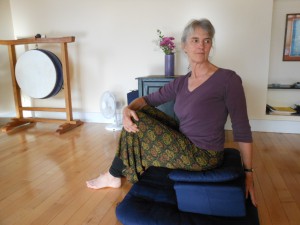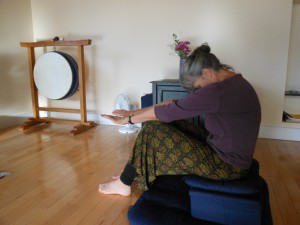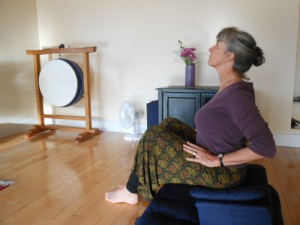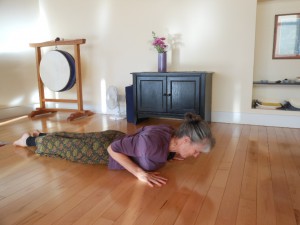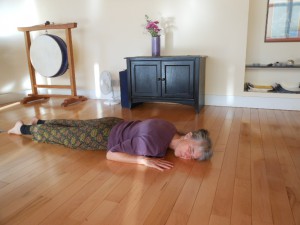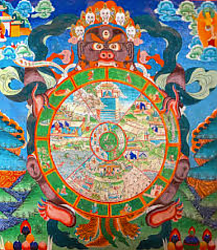Yoga to Help You Sit, Part 3: “Back” to Basics
By Martha Whitney and Trina Magi
Many meditators experience back pain or discomfort, even if they’ve never had back trouble or a back injury. In Part 3 of this series, we share strategies for a happier back. “When I first started to meditate, I remember feeling discouraging discomfort in my upper back. Even with a regular yoga practice, I had to learn how sit on a cushion. Happily, I found with practice my back strengthened and the discomfort went away. Unless you have a back problem related to an injury or structural problem, the following tips could help you as they helped me,” says Martha.
1) Sit on something higher. Sometimes we’re not able to relax into our cushion because our hips and ankles won’t allow it. This creates tension higher in the body, often between the shoulder blades. In our next column, we’ll give advice for opening the hips. For now, try adding an extra cushion, sitting on a chair, or using props to support your knees. (See Yoga to Help You Sit, Part 1.)
2) Pay attention to alignment. If your hands are resting too far forward on your legs, your shoulder blades will be forced to spread, and your heavy head (which weighs about 10+ pounds) will be pulled forward, putting strain on your back. Slide your hands back so that your elbows hang loosely, in line below your shoulders. Align your head right over your pelvis. Maintain a slight curve in your lower back. You can check this by feeling your lower spine. If feel the little knobs of your vertebrae your back is rounded; rather you should feel a subtle hollow depression along your spine. To find it, tilt your tail slightly back.
3) Relax! We may habitually hold tension in our bodies without knowing it—until we try to sit in meditation. When you take your seat, take a moment to relax and feel your weight going into the cushion or chair. Do a body scan (see Yoga to Help You Sit, Part 2), identify areas of tension, and see if you can let them go. Enjoy a few sighs and extend your exhalations. A longer out-breath encourages the relaxation response.
Three simple yoga stretches can help you release tension in the back: seated cat and dog, and a spinal twist. They can be done unobtrusively without leaving your seat. For seated cat, curl your tailbone under and round your back, rolling through each vertebra, tucking your chin, and stretching your arms forward, resting them on your knees.
For seated dog, tilt your tailbone up and arch your back, moving through each vertebra, lifting the chin, and moving the shoulders back. Go back and forth between cat and dog about five times.
For spinal twist, place your feet on the floor in front of you, bring your left hand behind you on your seat, and place your right hand on your left knee. Lengthen your spine and gentle twist to the left. Breathe easily in and out. Repeat in the opposite direction.
4) Strengthen your back. Sitting up straight in meditation posture may require you to use muscles that you aren’t accustomed to using. Simply spending more time in sitting meditation will strengthen your back. You can also try a yoga pose called low cobra. Lie on your stomach with your hands under your shoulders. Press the pelvis down as you lengthen through the legs and toes. On an in-breath, draw your heart and head off the ground to an easy height. On your exhale, roll down, turning your head to one side and placing your ear to the floor. Repeat the whole movement, ending by turning your head to the opposite side. Do three sets of these each day. Enjoy!

